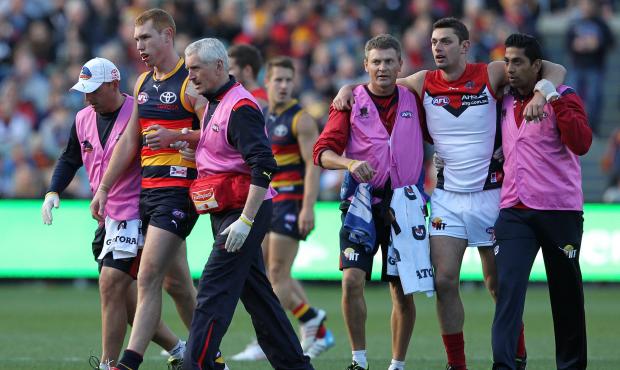On May 5, a surgeon fitted one plate over a break high in the jaw, and placed another over a lower break.
Lynch hasn't played football since and won't play again until June 21, at the earliest.
Click here for more Damian Barrett
As impactful as Viney's bump was on the Crows forward on that day in round seven, it has actually had a greater and equally concerning impact on the manner in which on-field collisions have since been policed.
When Viney successfully challenged his initial two-week ban, with a baying, frothing-at-the-mouth people-power group backing him and his cause for supposed justice, it was said by seemingly everyone, bar the lone voice in this column, that the right outcome had been reached.
And that in reaching that outcome, football had been saved from death.
Hallelujah.
But in the four weekends of football since, there has never been more confusion surrounding what a player can and cannot do in legitimate contact incidents.
And that is saying something, given that confusion has shrouded the workings of the Match Review Panel and Tribunal system since Adrian Anderson introduced it in 2005.
Pre-Viney – for rounds one through six - the AFL system was actually working well, possibly for the first time in its existence showing consistency at all levels.
Post-Viney, in the four weekends of football since, it has been frustratingly puzzling again.
Players have no idea what they are allowed to do in certain contests, and have even less certainty on how the AFL system – an umpire, MRP member, tribunal member or appeals tribunal member - will subsequently judge them for their actions.
As for the AFL system itself, it seems as though it doesn't want to again subject itself to the fury experienced in the Viney week.
So everyone escapes sanction now for incidents which, pre-Viney, would have been penalised.
Essendon's Heath Hocking placed his head in his own hands in an "Oh, no, what have I done?" action after he contacted Richmond's Ben Lennon last weekend. An umpire reported him immediately. Yet the MRP said he was contesting the ball and had no alternative. Hocking was cleared.
Tom Lynch and Alex Georgiou leave the ground after the Jack Viney collision. Picture AFL Media

The previous week, the Bulldogs' Adam Cooney contacted Gary Ablett's head. An umpire reported Cooney. Yet the match review panel ruled Cooney was contesting the ball and had no realistic alternative.
We'll keep going, back to round nine (two weeks post-Viney). The Swans' Daniel Hannebery made head contact with Essendon's Michael Hurley. You guessed it. Hannebery was "contesting the ball" and "did not have a realistic alternative".
None of Hocking, Cooney and Hannebery meant harm on those they contacted. But we would argue very strongly here that pre-Viney, all three players would have copped sanctions.
Poor old Daniel Giansiracusa. He was a week early in his clash with Adelaide's Patrick Dangerfield. He was given 125 points, which was offset by a good record and early plea. But had it been post-Viney we would likely have been told Giansiracusa had no alternative and not copped a sanction at all.
Back to the emotion-charged Viney week. The MRP washed its hands of the Viney-Lynch incident, sending it straight to the tribunal, which hit Viney with a two-week ban.
The tribunal was adamant it made the right decision, that it adjudicated to the rules as they stand, and this column agreed then with that outcome and still does.
This is the rule: Rough Conduct (Head-high Contact). Where in the bumping of an opponent (whether reasonably or unreasonably) the Player causes forceful contact to be made with any part of his body to an opponent's head or neck unless:
a. the Player was contesting the ball and did not have a realistic alternative way to contest the ball; or
b. the forceful contact to the head or neck was caused by circumstances outside the control of the player which could not reasonably be foreseen.
Two of the three tribunal members that night, Wayne Schimmelbusch and Wayne Henwood, have since been considering their role in the AFL system.
They both refused to comment about this matter when contacted last week, but it is known they feel badly let down by public comments made by AFL chief executive Andrew Demetriou in support of Viney before his appeal was heard.
It is also know they were left bemused by the decision of the AFL Appeals Board to overturn their decision.
The Appeals Board found the loophole the public was so desperate for it to find when it deemed Viney 'braced' for contact with Lynch, and didn't 'bump' him.
Need more evidence of the confusion post-Viney? Have an off-record conversation with a footballer or coach. Pretty much any footballer or coach.
Listen carefully to the few coaches who are prepared to publicly speak their mind on this topic. Brad Scott, for one. He gets it.
Nathan Buckley is another and of course, there is Paul Roos.
Roos, whose calm, confident ways can regularly reflect an entire industry's views, said this week: "We seem to think we're getting to a point and the bar changes again and we're back to square one or we're back three steps. That's probably the hardest thing.
"The footy public constantly gets confused by decisions. It's everything, it's not just the bump. I get surprised there's no consistency."


